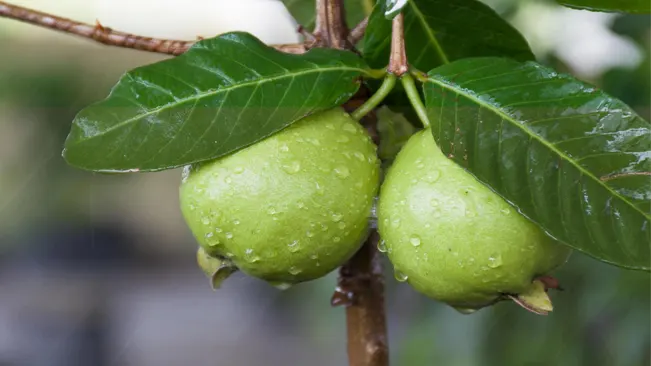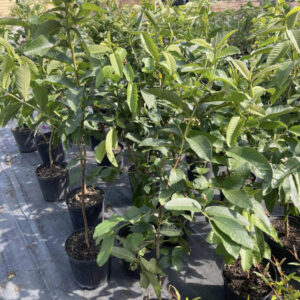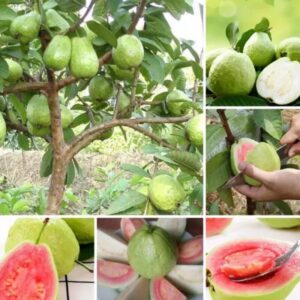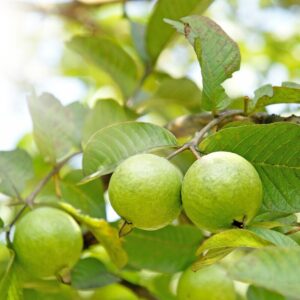Have you ever wondered how to grow guava trees in your backyard or even in a pot? Maybe you’ve seen those luscious guava fruits at the market and thought, “Could I grow this at home?” If so, you’re not alone. Guava trees are not only beautiful, but they’re also incredibly rewarding to grow. Plus, they can thrive even in small spaces with the right care.
In this guide, I’ll walk you through everything you need to know about growing guava trees—from choosing the right variety to harvesting your first delicious fruit. Whether you’re a seasoned gardener or a complete beginner, this step-by-step guide will help you get started. Let’s dive in!
Why Grow a Guava Tree?

Guava trees (Psidium guajava) are a fantastic addition to any garden, thanks to their versatility, low-maintenance nature, and high productivity. Not only do they produce delicious fruit with a sweet and tangy flavor that is rich in vitamin C, but they also offer year-round greenery, enhancing the beauty of any landscape. These evergreen trees are space-saving and can thrive both in the ground and in large pots, making them perfect for small gardens. Additionally, their charming flowers attract bees and other beneficial pollinators, contributing to a healthy and vibrant garden ecosystem.
Choosing the Right Guava Variety
Did you know there are different types of guavas? Picking the right variety is the first step to success. Here are some popular options:
-
Tropical White Guava: Sweet and aromatic, perfect for warm climates.
-
Ruby Red Guava: Known for its vibrant pink flesh and juicy flavor.
-
Pineapple Guava (Feijoa): A cold-hardy variety with a unique tangy taste.
Pro Tip: If you’re in the United States, check your USDA hardiness zone. Guava trees thrive in zones 9-11, but some varieties like Pineapple Guava can tolerate colder zones.
Planting Guava Trees: Step-by-Step Guide
1. Climate and Location
Guava trees thrive in full sun and are best suited for USDA Zones 9-11. To keep your guava tree happy, especially if you’re growing it in a greenhouse, ensure a warm and humid environment. Installing a simple misting system can help maintain the required humidity levels, but be cautious not to overdo it, as excessive humidity can lead to rust fungus on the leaves.
During warm spring or summer months, guava trees can be moved outside to bask in the sunshine, but they are highly sensitive to frost, so it’s essential to protect them from even the slightest chill.
Guava trees love sunlight. Find a location that gets at least 6-8 hours of direct sunlight daily. If you’re planting indoors, make sure you have a bright, sunny window or use grow lights.
2. Prepare the Soil
Guavas prefer well-draining soil with a pH of 5 to 7, ensuring the roots don’t sit in waterlogged conditions, which can lead to rot. If your soil is clay-heavy, mixing in sand, compost, or organic matter can improve its texture and drainage.
3. Plant Your Guava Tree
When planting your guava tree, you can choose to grow it either in the ground or in a pot, depending on your available space and preferences.
In the Ground:
-
Start by digging a hole twice as wide and just as deep as the tree’s root ball. This allows the roots to spread easily in loosened soil.
-
Place the tree in the hole, ensuring it sits at the same depth as it was in its original container.
-
Fill the hole with soil, gently firming it around the base to eliminate air pockets.
-
Water thoroughly to help settle the soil and establish the roots.
In a Pot:
-
Choose a large container with drainage holes to prevent waterlogging.
-
Fill it with a well-draining mix of potting soil, compost, and perlite for optimal root health.
-
Plant the tree at the same depth it was in its original container, and water thoroughly.
-
Place the pot in a sunny location, and ensure regular watering to keep the soil moist but not soggy.
4. Water Wisely
Guava trees thrive in consistently moist soil, but it’s crucial to avoid overwatering, as it can lead to root rot. Check the topsoil regularly—water when it feels slightly dry to the touch, but ensure the soil has good drainage to prevent waterlogging.
For guava trees grown in pots, be particularly mindful of overwatering, as containers retain moisture longer.
During dry or hot periods, you may need to water more frequently, while in cooler months, reduce watering to match the tree’s lower water needs. Always aim for a balance that keeps the soil moist but not soggy.
Caring for Your Guava Tree
Once your guava tree is planted, it requires minimal maintenance to thrive. Here are the key steps to ensure its health and productivity:
-
Fertilizing: Guava trees are nutrient-loving plants. During the growing season, feed them with a balanced fertilizer (10-10-10) every 6-8 weeks. Alternatively, organic options like compost or well-aged manure work wonderfully to enrich the soil and support healthy growth.
-
Pruning: Regular pruning is essential to keep your guava tree healthy and maximize fruit production. Remove any dead, damaged, or crossing branches to prevent disease and improve airflow. Shaping the tree allows better sunlight penetration, which boosts fruit quality.
-
Pest and Disease Control: Watch for common pests such as aphids, whiteflies, and scale insects. Natural remedies like neem oil or insecticidal soap are effective for controlling infestations. To prevent fungal diseases, ensure good air circulation by avoiding overcrowding and keeping the area around the tree clean and weed-free.
Harvesting Guava Fruits
Guava trees typically begin producing fruit within 2 to 4 years after planting, depending on the variety. Knowing when to harvest is key to enjoying the best flavor and texture. Here’s how to tell if your guavas are ripe:
-
Color Change: The fruit’s color shifts from green to yellow or red, depending on the variety.
-
Softness: Ripe guavas feel slightly soft to the touch, similar to a ripe peach.
-
Aromatic Smell: A sweet, fragrant aroma is a sure sign that the fruit is ready to be picked.
When harvesting, handle the fruits gently to avoid bruising. You can pick them by hand or use pruning shears for a clean cut, ensuring the remaining tree branches aren’t damaged.
Growing Guava Trees in Containers

Don’t let limited space stop you from enjoying fresh guavas! Growing guava trees in containers is a great option, and here’s how to do it successfully:
-
Select a Suitable Variety: Opt for a dwarf variety, such as ‘Ruby Supreme,’ which is well-suited for container growth.
-
Choose the Right Pot: Use a large pot with a capacity of at least 20 gallons. This provides ample space for the roots to grow and prevents the tree from becoming root-bound. Ensure the pot has good drainage holes to avoid waterlogging.
-
Soil and Watering: Fill the pot with a well-draining mix of potting soil, compost, and perlite. Since container plants dry out faster than those in the ground, water regularly to keep the soil consistently moist but not soggy.
-
Fertilize Consistently: Feed your potted guava tree with a balanced fertilizer or organic compost every 6-8 weeks during the growing season to replenish nutrients.
Guava Tree Planting Tips
To ensure your guava tree thrives and produces an abundance of delicious fruit, keep these tips in mind:
-
Mulch: Apply a layer of organic mulch, such as straw, bark, or shredded leaves, around the base of the tree. This helps retain soil moisture, regulate temperature, and suppress weed growth. Make sure to keep the mulch a few inches away from the trunk to prevent rot.
-
Protect from Frost: If you live in a region prone to cold weather or frost, safeguard your guava tree during winter. Use a frost cloth or blanket to cover the tree on chilly nights, and consider adding a layer of mulch for extra root protection.
-
Pollination: While guava trees are self-pollinating, you can enhance fruit production by hand-pollinating. Use a small brush to transfer pollen between flowers, mimicking natural pollinators like bees. This is especially useful in areas with low pollinator activity.
Common Questions About Growing Guava Trees
1. Can I grow guava trees indoors?
Yes, you can grow guava trees indoors if you have enough sunlight or a grow light. Choose a dwarf variety for best results.
2. How much water does a guava tree need?
Water deeply once or twice a week. In hotter climates, you may need to water more frequently.
3. Do guava trees need a lot of maintenance?
Not really! Guava trees are low-maintenance as long as you provide sunlight, water, and occasional fertilizer.
4. What’s the best time to plant guava trees?
Spring is the ideal time, but in warm climates, you can plant guava trees year-round.
Final Thoughts
Growing a guava tree is easier than you think. With a little care and patience, you’ll enjoy fresh, juicy guavas straight from your garden. Plus, the joy of watching your tree flourish makes the effort truly worthwhile.
So, what are you waiting for? Grab a guava sapling and get started today!
FEATURED PRODUCTS FOR YOU

















